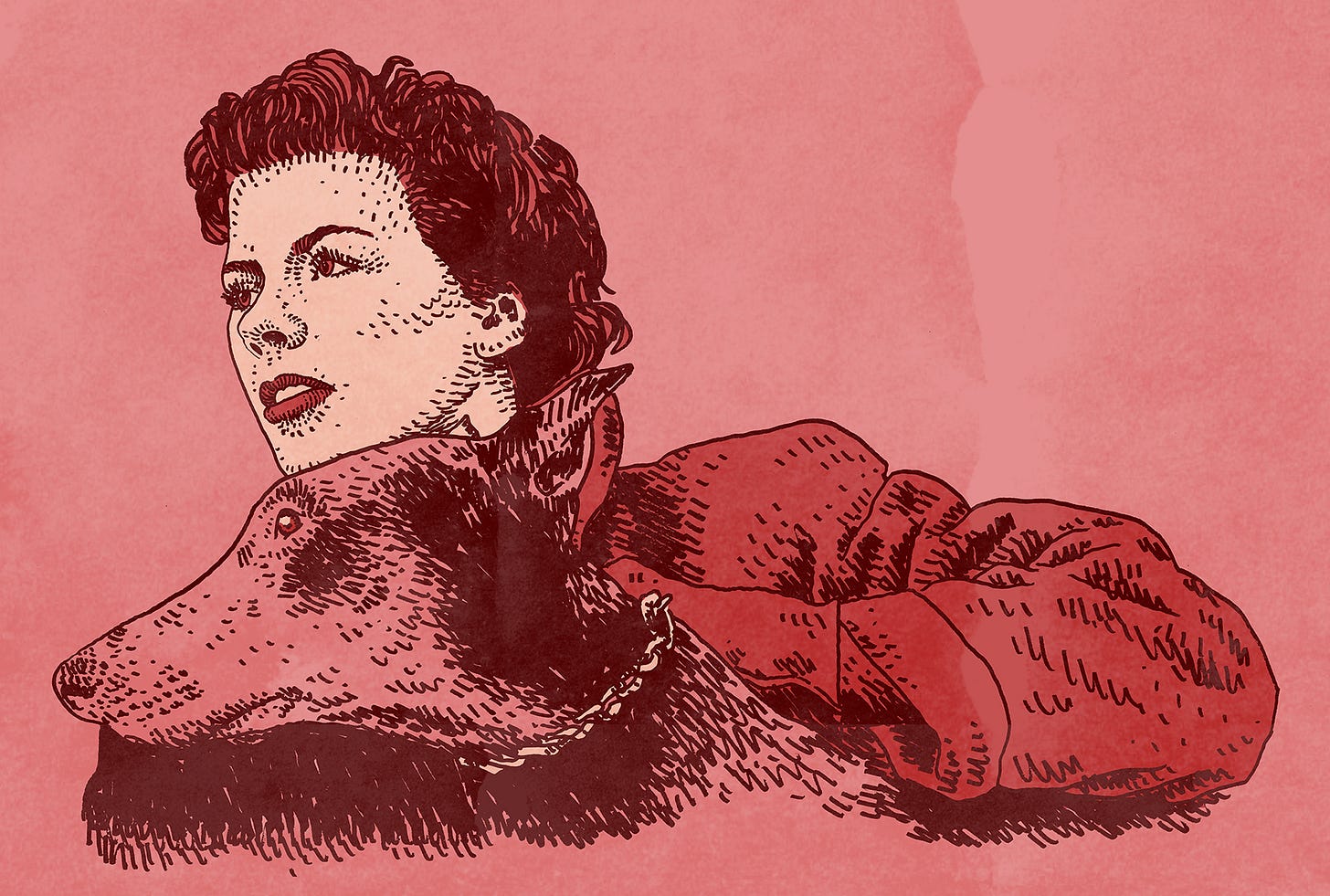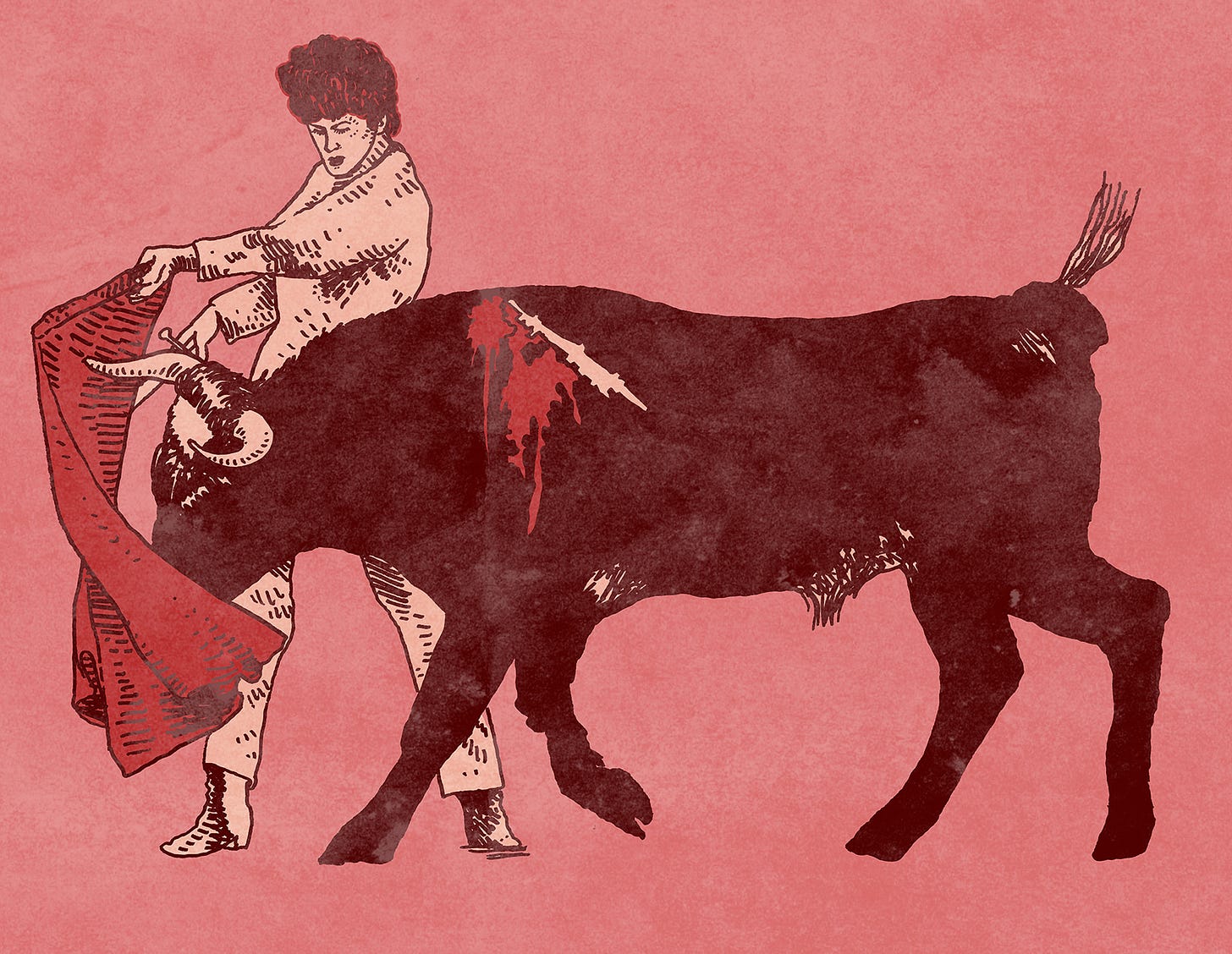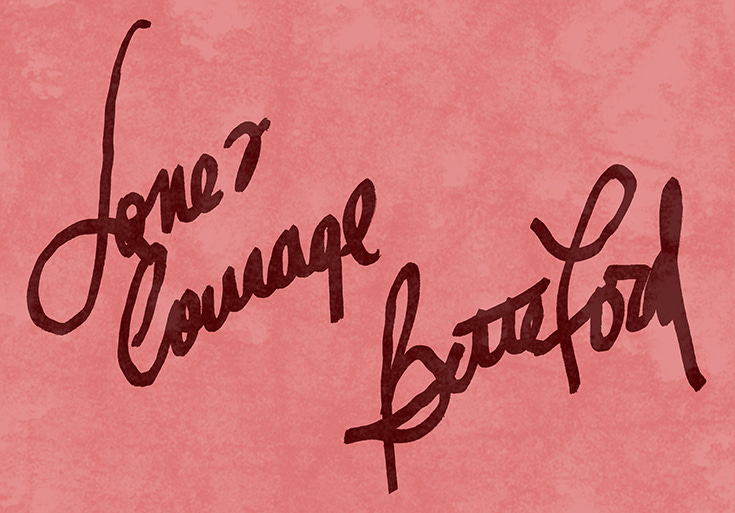Love & Courage
In 1951, Bette Ford dropped out of her modeling career to become a world-renowned matador.
Many years ago, when I lived and worked in Mexico City, I wrote a short article for “Outside” about bullfighting. The gist was this: I questioned whether the spectacle and ritual beauty of a bullfight was worth the cost. I also wondered whether the life of a fighting bull -- pampered and content until the cruel drama of its public death -- was actually worse than the life and death of a regular old cow stuck in a pen and either milked or killed by assembly line machines.
No single story I’ve published before or after has resulted in a louder, angrier, or meaner series of reactions from readers. Thankfully, Outside seems to have scrubbed the comments from their website. There were some emails too.
The point of all this is that for many people bullfighting is a source of great cultural pride. Attacks on it are felt in a personal way. It is a meaningful, almost religious act. I understand this. The grace and power and danger on display in the circle are unrivaled by any other sport. Bullfighting — aficionados are quick to point out — is not even a sport. This seems fair to me. It is a rite: A traditional animal sacrifice. A sort of recurring Passion Play. Each bullfight is a distinct work of art and a reminder that we humans are -- as much as the bulls themselves -- just big dumb primordial animals.
This is the sort of reverent, literary take at least -- think Hemingway in “Death in the Afternoon” writing in excruciating detail and with deep awe about bullfighters and bullfighting. (It is a very boring book, in my opinion) But the truth is, Hemingway did a better job capturing bullfighting, and how bullfighting looks under the gaze of Americans in “The Sun Also Rises.” In that book, a bunch of drunk tourists drive around Spain and go to bullfights and generally act like idiots.

Which brings us to Bette Ford, the subject of this week’s Sports Stories. The quick version of Bette Ford’s story seems like something easy to dismiss, or trivialize: she was an American actress and model who left her career behind in the early 1950s to move to Mexico and become a matador. She was the subject of an Oscar-nominated documentary short called “Beauty and the Bull.” And at first glance, that’s where it seems like it might end: Bette Ford, fun fact. After all, the title of the film doesn’t exactly lend itself to serious-mindedness about Ford’s craft as a bullfighter.
But Bette Ford was actually great at bullfighting. She was a serious student of the art -- courageous and ruthless and deeply entrenched in the culture. Ford’s path to bullfighting was odd but sort of natural in retrospect. The dominoes start falling and years go by and suddenly you have gone from a small town beauty queen in Pennsylvania to a swimsuit model in New York to the main attraction at the world’s biggest bull ring. Totally natural.
In all seriousness, Ford (born Harriet Elizabeth Dingeldein) was on a modeling assignment in Bogotá, Colombia when she was introduced to the famed matador Luis Dominguín. Dominguín invited Ford to see him in action. The performance by astounded her -- the entire spectacle of the bullfight did -- and she went back to New York unable to shake it. As Ford herself described to Marie Claire (in a really lovely feature by the magazine), she went back to New York and papered her apartment walls with bullfighting posters. She daydreamed of bulls and bullfighters. Finally, she and a boyfriend ditched New York all together and drove down to Mexico to see what was what.
Ford’s career took off quickly. She accidentally became the subject of a feature story in a local Mexican newspaper in Juarez. Then she caught the eye of a promoter. All of a sudden, she was being featured in plazas de toros across Mexico. She was a natural performer and that showed in the ring, where she quickly gained a following not just as a novelty act but as a graceful and deadly matador. Ford was not the first American woman to attain stardom on the bullfighting circuit in Mexico -- that honor belonged to Patricia McCormick -- whose story is fascinating in and of itself.
(Ford and McCormick were often cast as rivals in the bullfighting press and in tabloids. I haven’t found much proof that the two women held any sort of grudge, but here’s an *incredibly* sexist old Sports Illustrated story that tries to pull these strings.)

The rivalry was built up so that in 1955, Ford and McCormick might appear in competition at Plaza México in Mexico City -- the world’s largest bullring. No woman had ever fought a bull there on foot (others had on horseback.) The occasion would be monumental. But for reasons that are not clear, it did not come to pass. It turned out that only Ford would be on the bill. And so in August of that year, before 50,000 screaming fans, Ford stepped into history.
By that time, Ford was already a celebrity. She palled around with actors and singers. Hemingway himself apparently called Ford “the most intelligent woman I’ve ever met” (which strikes me as more of a self-own than anything else.) A few months after the Plaza México appearance, she appeared on the cover of one of the very first issues of the Village Voice. What the interview reveals is a person who had completely given themselves over to their art. Ford was funny in parrying the Voice’s less substantive questions. (“Do you think bullfighting is sexual?” “Only visually.”) But she was also philosophical, talking about her strengths and weaknesses as a matador; and about how her sense of self had evolved in the ring. She could have been any artist (or any athlete) discussing their process.
One other thing Ford told the Village Voice? That after her career in bullfighting she would return to acting. Which is exactly what she did. Bette Ford stayed in the ring until 1958. It had been a good run: she had achieved glory and fame and had become a master of the art. She had also suffered from sexism and from the physical pain of hours and hours of practice and from the emotional toil of repeatedly risking her life. She had been gored badly. But she had come through it. She got married then, to a screenwriter named John Meston, and mostly disappeared from public view. Then in the late 1970s, she began to appear in movies and television shows. And for thirty years, she worked regularly as a character actress.
Ford never gave up her love of bullfighting either. In 2011, Ford gave an interview to the magazine Guernica on the occasion of the passage of a bullfighting ban in Catalonia. It’s a truly fascinating conversation, not just about her own career but about the ethics of the sport in general. I can’t recommend it highly enough. Ford’s interlocutor, Fortunato Salazar, asked great questions and got great answers.
One such answer:
Perhaps Madrid will go the way of Catalonia eventually. And then what’s next…banning the Catholic church? Soccer? It’s almost impossible to imagine bullfighting abolished from Spain entirely. Values do change, though. One of the things I’ve been thinking about lately is how the change in values makes the survival of the old values, where they do survive, all the more striking.
This is a question that applies to much more than bullfighting, of course. It applies to our traditions of government, to the monuments we erect (physical and metaphysical), to the buildings we do and don’t knock down in the name of progress. Values change. The way we think about the social costs of our actions changes. Displays of the old values like bullfighting might be, in Ford’s words, “striking.” But “striking” does not necessarily mean right.
Just because something has been done for a long time do we need to keep doing it? Just because something is beautiful does it mean we need to hold onto it? And does letting go of it now make what happened before any less meaningful?

Related Reading
The aforementioned Guernica interview is where I would start. Then I’d read the Marie Claire profile on Ford by the same writer, Fortunato Salazar. (Salazar gets a lot of credit for writing+discussing bullfighting in a way that is clearly expert but also easy to follow for people who are not as familiar with the practice.)
After that, I’d listen to this lovely instrumental song about Ford by Mariachi Continental de Miguel Diaz which we can hear thanks to UCLAs incredible archive of border music.
If you’re not lost in that aforementioned archive, check out the Village Voice feature. Unfortunately, I couldn’t find a copy of “The Beauty and the Bull” to watch. But you can always check out Ford’s IMDB page and then turn on one of the many movies and TV shows she’s appeared in.
I also enjoyed this Pittsburgh Post-Gazette feature on Ford on the occasion of her induction into the McKeesport Area High School Hall of Fame. If you want even deeper reading, there were a few good articles on Ford in the LA Times in the 1950s -- but you need archival access for those.
The Texas Torera
I said earlier that Patricia McCormick’s story was fascinating in its own right. She wrote a memoir, published in 1954, called Lady Bullfighter, and she passed away in 2013. Before that, she was the subject of a documentary film. I couldn’t find the film, called “The Texas Torera.” But here’s a wonderful little clip featuring McCormick’s own voice and some great footage from the 1950s:



on BF, there's also this: https://lithub.com/the-biography-ill-never-truly-finish-writing/